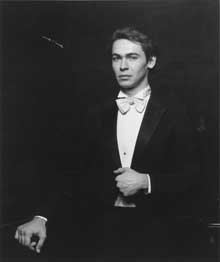| Available at Amazon: Ivo Pogorelich - Recital (released on June 14, 2005) |
 The first section of this DVD is devoted to Baroque music, played on a Steinway in two beautiful rooms in the Villa Caldogno, completed by Andrea Palladio in 1570, near Vicenza. Pogorelich is probably the most formidable and unorthodox player of Baroque keyboard music since Glenn Gould. He generally favors fast tempi, crisply detached articulation, and rhythmic severity. His playing is rigidly intellectual, and his demeanor is never theatrical (no distracted humming à la Gould or self-indulgent swaying à la Lang Lang).
The first section of this DVD is devoted to Baroque music, played on a Steinway in two beautiful rooms in the Villa Caldogno, completed by Andrea Palladio in 1570, near Vicenza. Pogorelich is probably the most formidable and unorthodox player of Baroque keyboard music since Glenn Gould. He generally favors fast tempi, crisply detached articulation, and rhythmic severity. His playing is rigidly intellectual, and his demeanor is never theatrical (no distracted humming à la Gould or self-indulgent swaying à la Lang Lang).Pogorelich keeps his face an impassive mask, with at most a slight crease of his lips indicating moments of particular tension. Although his attack is often strident -- he's a remarkably strong player -- each piece is also shaded with impressive subtlety. For example, the Allemandes and Sarabandes of the two J. S. Bach English Suites (no. 2 in A minor, BWV 807, and no. 3 in G minor, BWV 808) are dances of tender lyricism, lute interludes by comparison to the grander, more orchestral preludes and gigues. The six sonatas by Domenico Scarlatti (most on view at YouTube: no. 5 in C major, no. 17 in E major, no. 19 in E minor, no. 35 in G minor, no. 15 in D minor, and no. 3 in C major) are all charming miniatures. (Speaking of terrifyingly good playing, take a look/listen at Martha Argerich playing Scarlatti's K. 141, making Chico Marx-like child's play of those repeated notes. I can waste a lot of time at YouTube.)
Ivo Pogorelich playing Scarlatti, K. 159
The Baroque portion is followed by two pieces by Beethoven, beginning with the lesser-known eleventh sonata (B-flat major, op. 22, from 1800). Pogorelich's Beethoven is virtuosic and technically awe-inspiring but a little too abrasive for my taste. The Beethoven set concludes with a little bagatelle Beethoven did not even give an opus number, Für Elise. Judging by Pogorelich's rare emotional facial expression during this sweet performance, I would guess that the piece has a personal significance: perhaps that the dedicatee's name is similar to that of his wife, Aliza?
Jens F. Laurson, Dip Your Ears, No. 3: Scarlatti Sonatas (July 8, 2004) Jens F. Laurson, Ivo Pogorelich: Phoenix or Swan Song? (November 4, 2004) |
Tomorrow evening, Washingtonians have the opportunity to hear Ivo Pogorelich live: there are still tickets for his recital (October 22, 7 pm) at the George Mason University Center for the Arts, way out in Fairfax. It is the same venue where he played on his last trip to the Washington area, two years ago, when he was received with generous ovations. I have no idea what he is planning to play, but it should be worth the trip. Tickets are cheap, from $22 to $44.
Deutsche Grammophon NTSC 073 404-5
UPDATE:
Two major critics have savaged Ivo Pogorelich's American appearances this week:
- Tim Page, Ivo Pogorelich at GMU: Piano in an Unnatural Key (Washington Post, October 24)
- Anthony Tommasini, After a Decade Away, an Elusive Figure Returns (New York Times, October 28)
I almost feel vindicated. Tony T's description of op.111 is almost identical with mine - and the tenor is similar to the one I attributed to most of the first half. Donald H. Crosby, who wrote the 'emergency review' for the WP after mine was axed, felt curiously different about no.32, but otherwise similar.
ReplyDeleteOnly that the second part of the concert - well, at least the Liszt - back then was worthwhile.